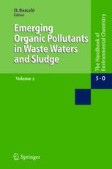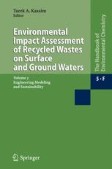Search
Search Results
-
Occurrence, Fate and Relevance of Aminopolycarboxylate Chelating Agents in the Rhine Basin, Germany
Aminopolycarboxylates are used in many products and industrial applications because of their ability to form stable complexes with metal ions. The...
-
Analysis, Occurrence, and Fate of Aromatic Sulfonates in the Rhine and Its Tributaries
An overview is given of the occurrence of aromatic sulfonates in the Rhine river and its tributaries. Since 1990, 25 different monomeric sulfonates...
-
Patterns of Seasonal and Interannual Variability of Remotely Sensed Chlorophyll
Seasonal and interannual variability of chlorophyll dynamics in the Caspian Sea remotely sensed by the Sea-viewing Wide Field-of-view Sensor...
-
The São Francisco Estuary, Brazil
This is a first account of the physical and biogeochemical characteristics of the tropical São Francisco (SF) estuarine system, East Brazil,...
-
The Development of Water Protection Requirements from the Point of View of Waterworks, with Emphasis on 30 Years of the Memorandum of the International Association of Waterworks in the River Rhine Catchment Area (IAWR)
The International Association of Waterworks in the River Rhine Catchment Area (IAWR) defined water protection requirements for surface water that...
-
Recycling Solid Wastes as Road Construction Materials: An Environmentally Sustainable Approach
Improved environmental performance in industry and society is a concept now a quarter-century old. Efforts in this regard have yielded much in the...
-
Fragrance Materials in Wastewater Treatment
In recent years, there has been significant interest in understanding the input of fragrance materials (FMs) to aquatic ecosystems, and this has...
-
Estrogens and Progestogens in Wastewater, Sludge, Sediments, and Soil
Estrogens and progestogens are two classes of female steroidal hormones whose presence in the environment has been associated with the appearance of...
-
A Review of Roadway Water Movement for Beneficial Use of Recycled Materials
The purpose of this chapter is to provide a comprehensive review of water movement in roadways so that this knowledge may be used in environmental...
-
Forensic Investigation of Leachates from Recycled Solid Wastes: An Environmental Analysis Approach
In order to study the environmental analysis and impact assessment (EAIA) of contaminants leached from road construction and repair (C&R) materials,...
-
Wastewater Quality Monitoring: On-Line/On-Site Measurement
Sampling and laboratory analysis are not well adapted to wastewater quality monitoring in a process control or hazards prevention context, for which...
-
Evaluation Methodology for Environmental Impact Assessment of Industrial Wastes Used as Highway Materials: An Overview with Respect to U.S. EPA's Environmental Risk Assessment Framework
An evaluation methodology was developed for assessing potential ecological risks posed by constituents released from waste and industrial byproducts...
-
Evaluation of Pesticides in Wastewaters. A Combined (Chemical and Biological) Analytical Approach
The current status of the analysis of pesticides in wastewater by chromatographic techniques and toxicity bioassays is reviewed and evaluated. When...
-
Applicability of Models in the Field of Environmental Chemistry of the MediterraneanSea
The present chapter highlights the problems facing when modelling the marine environment, in particular for biochemical aspects. It is shown how the...
-
Importance of Visible Light-Induced Photo-oxidationProcesses in the North-Western Mediterranean Sea
Recently, there has been a renewal of interest concerning the study of heterogeneous visible light-induced degradative reactions of lipid compounds...
-
Biological Indicators in Mediterranean Coastal Waters: a Link betweenEnvironmental Chemistry and Ecological Assessment
The initial approach to monitoring contaminants in the aquatic environment was direct measurement in the natural waters, but chemical analysis of...
-
Surface-Active Properties of the Sea Surface Microlayerand Consequences for Pollution in the Mediterranean Sea
Most biogeochemical processes in natural waters take place at different phase discontinuities, among which the largest one is the atmosphere–ocean...
-
Exchange of Pollutants (Trace Elements) at the Sediment Boundary
Marine sediments are the final depositories of trace elements entering the marine environment but they can also act as a source. In the Mediterranean...
-
Solidification/Stabilization Technologies for the Prevention of Surface and Ground Water Pollution from Hazardous Wastes
Solidification/stabilization treatment processes immobilize hazardous constituents in the waste by changing these constituents into immobile...
-
Leaching from Residues Used in Road Constructions – A System Analysis
When residues such as municipal solid waste incineration slag are used as construction materials they are commonly enclosed in a technical...
